Life has a way of surprising people, often for the better. Four faculty panelists helped kick off the weeklong Pathways to Pharmacy 2018 career exploration program at NEOMED with an admission: Their ideal plans for a career in pharmacy were derailed or altered. There’s a happy ending, though: They truly enjoy the jobs they have now.
Daniel Krinsky, R.Ph., associate professor of pharmacy practice, shared with the high school sophomores, juniors and seniors that he planned to graduate from the University of Toledo, move to Vermont, open a pharmacy and breed Golden Retrievers. Instead, he got into clinical pharmacy and ended up moving South to Alabama, then eventually back home to Northeast Ohio.
Philip King, Pharm.D. (’13), assistant professor of pharmacy practice; Chris Paxos, Pharm.D., associate professor of pharmacy practice and psychiatry; and Mate Soric, Pharm.D., associate professor of pharmacy practice, also shared their career journeys with the group of eager students assembled for the first day of the pharmacy careers program.
Finding the right pathway to pharmacy.
Finding the right pathway to pharmacy
When Dr. King graduated from the University of Toledo, he liked all aspects of pharmacy so much that he completed two postgraduate year (PGY) residencies, during which he discovered a passion for teaching. Now, he is a shared faculty member at NEOMED and practices neurology pharmacy, where he treats patients in critical care who may have suffered seizures, traumatic brain injuries or strokes.
“I see patients come in paralyzed and a few days later, walk out of the hospital. It’s so rewarding as professionals to make an impact on others,” says Dr. King.
For Dr. Soric, the decision to pursue a career in health care—specifically pharmacy—was easy, thanks to the unwavering encouragement of his mother. Although he had his heart set on community pharmacy, during one of his last rotations Dr. Soric quickly fell in love with the hospital side of pharmacy. Today, he serves as a clinical pharmacy specialist at University Hospitals Geauga Medical Center.
Ask the pros
From daily duties to hours and pay, the students proved to be curious about the pharmacy profession. The four panelists were prepared to answer questions such as the ones below.
What is a typical day at your job? “Education is a big piece, for providers and patients,” says Dr. Paxos. “We educate on medications, find affordable options and more.”
What are the hours and pay like in a clinical pharmacy versus community pharmacy? Dr. King explained that there are so many factors in the mix that it’s hard to give a single answer. Among other things, “It depends what part of the country you’re in; if you’re clinical or community; and so on,” he noted. Fady Abdlrasul, Pharm.D. ('14), assistant professor of pharmacy practice, added that clinical pharmacists usually work in hospital settings from 7 a.m. to 3 p.m. and make an average of $50-60 per hour, while community pharmacists in stores or pharmacy businesses work longer 12-hour shifts, but work fewer days per week.
Are there federal pharmacy jobs, like with the Centers for Disease Control and Prevention? There are. In fact, the U.S. Department of Veterans Affairs (VA) is one of the biggest federal pharmacy employers, Dr. Soric noted. The FDA often hires pharmacists as well.
While job descriptions and pay will vary, the fundamental role of a pharmacist remains the same, said Dr. Paxos: “We are there to treat patients and treat them as well as we can.”
